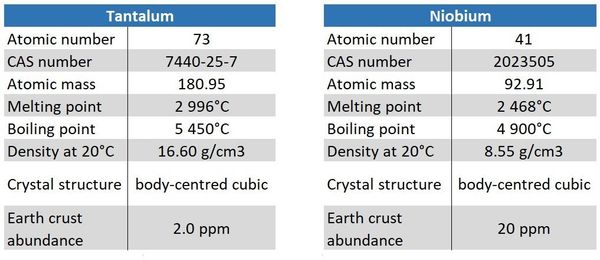Tantalum & Niobium
History
Tantalum was discovered in Sweden in 1802 by Anders Ekeberg. One year earlier, Charles Hatchett had discovered columbium (now niobium). In 1809 the English chemist William Hyde Wollaston compared its oxide, columbite with a density of 5.918 g/cm3, to that of tantalum, with a density of 7.935 g/cm3. He concluded that the two oxides, despite their difference in measured density, were identical and kept the name tantalum.
After Friedrich Wöhler confirmed these results, it was thought that columbium and tantalum were the same element. This conclusion was disputed in 1846 by the German chemist Heinrich Rose, who argued that there were two additional elements in the tantalite sample, and he named them after the children of Tantalus: niobium (from Niobe, the goddess of tears), and pelopium (from Pelops). The supposed element "pelopium" was later identified as a mixture of tantalum and niobium, and it was found that the niobium was identical to the columbium already discovered in 1801 by Hatchett.
The differences between tantalum and niobium were demonstrated unequivocally in 1864. The first relatively pure ductile metal was produced by Werner von Bolton in Charlottenburg in 1903. Wires made with metallic tantalum were used for light bulb filaments until tungsten replaced it in widespread use.
The name tantalum was derived from the name of the mythological Tantalus, the father of Niobe in Greek mythology.
Properties
Tantalum and Niobium is used to produce a variety of alloys that have high melting points, strength, and ductility. Alloyed with other metals, it is also used in making carbide tools for metalworking equipment and in the production of superalloys for jet engine components, chemical process equipment, nuclear reactors, and missile parts.
They are inert against most acids except hydrofluoric acid and hot sulfuric acid, and hot alkaline solutions also cause tantalum to corrode. This property makes it a useful metal for chemical reaction vessels and pipes for corrosive liquids. Heat exchanging coils for the steam heating of hydrochloric acid are made from tantalum. Tantalum was extensively used in the production of ultra high frequency electron tubes for radio transmitters. The tantalum is capable of capturing oxygen and nitrogen by forming nitrides and oxides and therefore helps to sustain the high vacuum needed for the tubes.
The high melting point and oxidation resistance lead to the use of the metal in the production of vacuum furnace parts. Tantalum is extremely inert and is therefore formed into a variety of corrosion resistant parts, such as thermowells, valve bodies, and tantalum fasteners.
Niobium is used in various superconducting materials. These superconducting alloys, also containing titanium and tin, are widely used in the superconducting magnets of MRI scanners. Other applications of niobium include welding, nuclear industries, electronics, optics, numismatics, and jewelry. In the last two applications, the low toxicity and iridescence produced by anodization are highly desired properties.ts, such as thermowells, valve bodies, and tantalum fasteners.
Our Products
- Tantalum and Niobium in pure form as well as their alloys
- Melted or sintered quality
- all common delivery form







